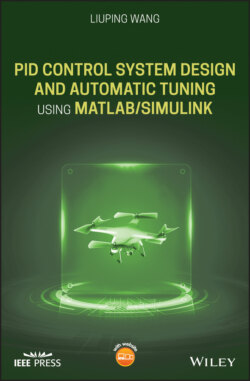Читать книгу PID Control System Design and Automatic Tuning using MATLAB/Simulink - Liuping Wang - Страница 39
Example 1.7
ОглавлениеA continuous time plant has the transfer function:
(1.57)
The unit step response of this transfer function model is shown in Figure 1.17. In this figure, a line is drawn to reflect the maximum slope of the reaction curve and the points of interest are marked by two arrows.
Using MATLAB command ginput(2), with a click on the bottom point, we will find the coordinates ; and a click on the top point, we will find . Find the PI and PID controllers using the reaction curve based tuning rules.
Solution. The steady state gain The time delay is and the parameter The PI controller parameters are calculated using the reaction curve based methods (see Tables 1.2, 1.3, and 1.6) and are summarized in Table 1.8. The closed-loop control systems with the PI controllers are simulated using the plant model (1.57). The unit closed-loop step responses are shown in Figure 1.18. From this figure, we can see that both PI controllers from Ziegler–Nichols and Cohen–Coon tuning rules failed to produce a stable closed-loop system. However, the PI controller using Wang–Cluett tuning rule gives a stable closed-loop system.
The PI control systems will be subsequently used as examples for closed-loop stability analysis. The Nyquist plots of the PI controllers used in this example are analyzed in Example 2.3 of Chapter 2.
The following example illustrates the applications of the Padula and Visioli tuning rules.
Figure 1.17 Unit step response (Example 1.7).
Table 1.8 PI controller parameters with reaction curve.
| Ziegler–Nichols | 6.4 | 108 | ||
| Cohen–Coon | 6.5667 | 75.9231 | ||
| Wang–Cluett | 3.8867 | 127.2154 |
Figure 1.18 Closed-loop unit step response with PI controller (Example 1.7). Key: line (1) Ziegler–Nichols tuning rule; line (2) Cohen–Coon tuning rule; line (3) Wang–Cluett tuning rule.
